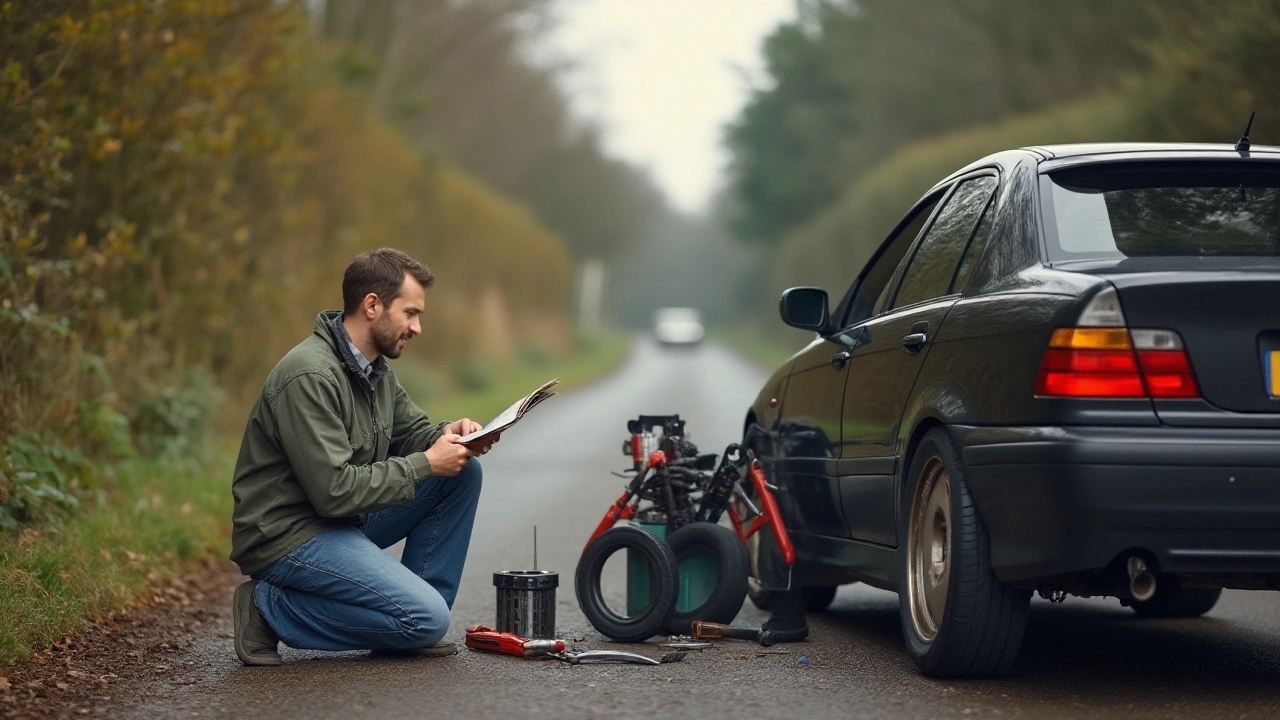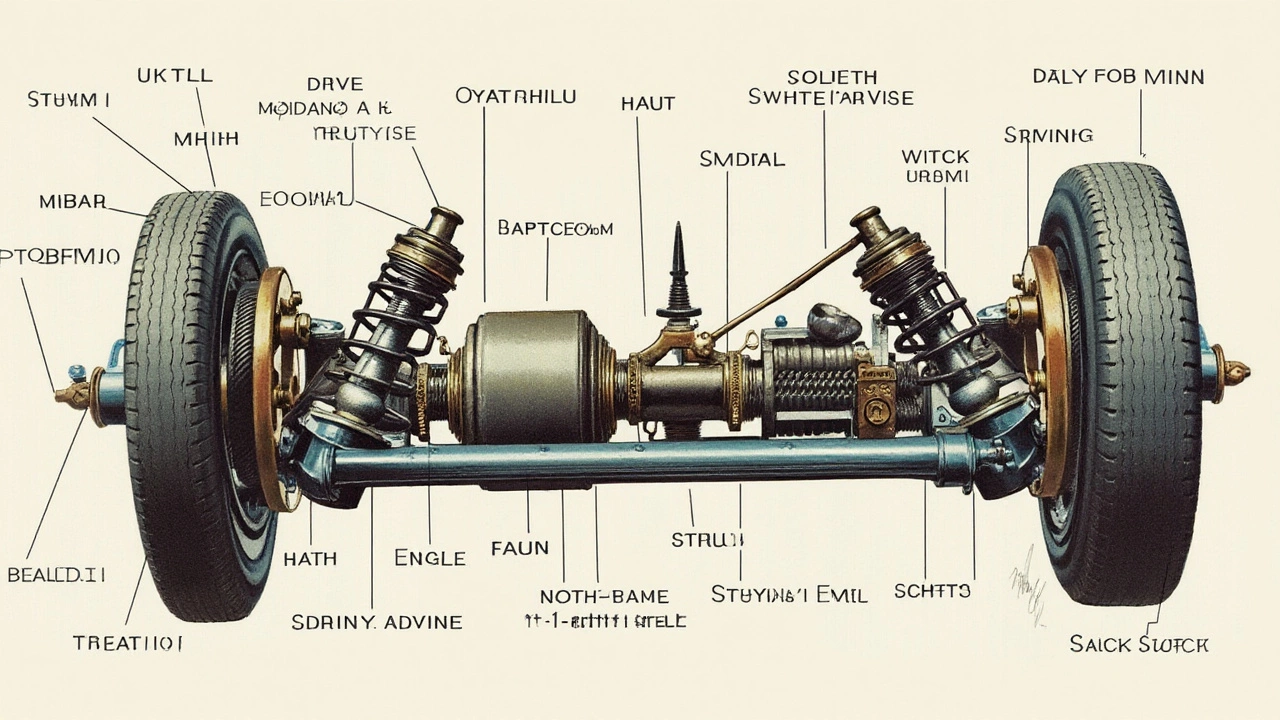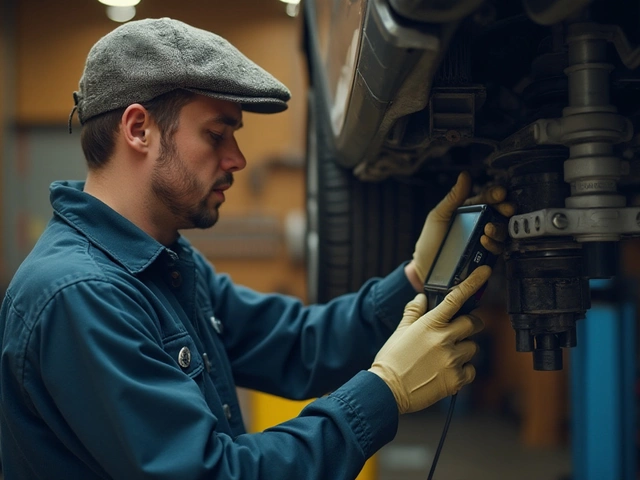Have you ever felt your car bouncing excessively or heard strange noises when navigating a bump? That’s your vehicle's way of hinting that it might be time to look into the suspension system. A bad suspension isn’t just uncomfortable; it can be downright dangerous.
This journey will guide you through understanding what makes up a vehicle suspension, how to detect if something’s amiss, and what steps you can take to address common issues yourself. Knowing when to call in an expert ensures your ride remains both safe and smooth.
- Identifying Suspension Problems
- Understanding Suspension Components
- Assessing the Damage
- DIY Repair Tips
- When to Consult a Professional
Identifying Suspension Problems
Your vehicle's suspension is more than just the system that absorbs shock and gives a smoother ride. It's a complex network designed to keep you in control, maintain tire-road contact, and provide head-to-surface guidance. When something goes wrong, it manifests in ways that might seem subtle but are crucial to acknowledge. The first step in identifying suspension repair needs is recognizing the red flags that hint at underlying issues.
One common symptom of a failing car suspension is uneven tire wear. Tires should wear out evenly, which indicates that they are consistently in contact with the road. Uneven patterns could mean your suspension is causing the car to ride unevenly. You might also notice a rough ride. If each bump on the road feels like you're hitting a pothole, it’s time to get your suspension checked. This gives you more physical cues like vehicle sagging to one side, which means the suspension isn't distributing weight properly.
Listen to your vehicle. Strange sounds like clunking, knocking, or squeaking, especially when driving over rough roads, could be signs of a loose or broken component within the suspension system. Pay attention to how your car handles. Does it dip or nose dive when you brake? That’s an alarming sign of suspension issues. Maybe your vehicle pulls to one side automatically. It could be due to incorrect alignment caused by suspension damage. Watch how your car performs in corners. If it sways or leans more than usual, that is often a red flag.
"A vehicle that doesn't handle properly isn't safe," reminds the ASE (Automotive Service Excellence) experts. They emphasize that ignoring suspension issues could compromise overall vehicle safety.
Statistically, according to recent automobile safety studies, about 60% of roadside accidents have been influenced by mechanical failures, where suspension issues play a considerate role. Stay alert for visible signs such as leaking shocks or struts. These can appear as greasy marks or physical oil drips around the tires. More importantly, trust your instincts. When something feels off, it likely is. Don’t procrastinate repairs just because the vehicle is still moving.
Understanding Suspension Components
Every car owner who wants to keep their vehicle running smoothly should have a basic understanding of what goes on beneath the chassis. The suspension system is not just about springs and shocks; it’s an intricate web of components working together to ensure your ride stays as smooth as a glide across a calm lake. From coil springs to control arms, each part of the suspension plays a vital role in maintaining comfort and stability while you drive. Picture the suspension parts as a well-organized party – if one member of the team loses rhythm, the entire setup can go offbeat, leading to unexpected and sometimes dangerous results.
In most vehicles, the suspension system is comprised of a few key components: springs, shock absorbers or struts, and torsion bars. Springs, which can be coil or leaf springs, essentially absorb the weight of the car and allow it to adjust and adapt to different terrains. They are the silent heroes that cushion the car's impact when it rolls over bumps. Shock absorbers function as a balancing act; they manage the bounce of the springs, ensuring the car doesn’t rock and sway excessively. In some setups, these shock absorbers are replaced by struts, which integrate several functions into one component, providing an added layer of steering control and support.
Let’s not overlook auxiliary components like control arms, ball joints, and stabilizer bars. Control arms connect the wheels to the frame of the car. They give the wheels the freedom to move up and down while keeping them aligned with the body. Ball joints, akin to hips or shoulders in a human body, allow for pivoting movements, accommodating the vehicle's changes in direction. Stabilizer bars, or sway bars, keep everything in balance, reducing body roll during sharp turns and providing a stable, even ride.
"Understanding the suspension system is critical, as its integrity directly affects the vehicle's handling, braking, and ride comfort," says John Rastelli, an auto industry analyst. "In essence, maintaining these components in prime condition should be a priority for any comprehensive vehicle maintenance routine."
Now, some might wonder how often they need to check these components or if there's any metric that dictates when replacements are necessary. According to data, industry experts suggest evaluating parts such as shock absorbers every 50,000 miles. In some vehicles, manufacturers provide specific guidelines, often found in your owner’s manual, ensuring each part operates as designed. Take a look at the table below for a quick reference on component longevity:
| Component | Recommended Check Interval (Miles) |
|---|---|
| Shock Absorbers | 50,000 |
| Springs | 80,000 |
| Control Arms | 70,000 |
Each vehicle can have its unique quirks, and besides the numbers, it’s crucial to trust your instincts. If your car starts behaving out of character, investigate those suspension parts sooner rather than later. A minor issue caught early is far cheaper and simpler to fix than waiting until it snowballs into a substantial problem.
By understanding these components, car owners aren't just improving their knowledge; they’re also ensuring their own safety and comfort. After all, the more you know, the better prepared you are to handle the challenges your vehicle may face on the open road.

Assessing the Damage
Diving into assessing the state of your car suspension is not just about peering under the chassis with a flashlight. It's about tuning into your vehicle and recognizing when something feels off. A keen focus on your driving experience plays a central role; this experiential information is sometimes more telling than what meets the eye. When evaluating the problem, first note any peculiarities like knocking sounds, excessive body roll during cornering, or uneven tire wear. These subtle hints can often point directly to the root issue, saving you hours of unnecessary tinkering.
One crucial step in assessing the condition of your suspension parts involves a thorough visual inspection. Begin with the struts and shock absorbers; when these components exhibit oil leakage or significant coating of grime, it's usually an indication they might be past their prime. Move on to the springs and look for any signs of noticeable sagging or rusting. Remember, though springs are built tough, they aren’t invincible to the elements, especially salt and moisture that can accelerate corrosion. Pay particular attention to the bushings at each joint – if these are cracked or torn, they could be contributing to the wear on adjacent parts.
Before jumping to conclusions, consider performing a bounce test. It's as simple as it sounds but can reveal a lot about your suspension repair needs. Push down firmly on the front or rear end of your vehicle, and see how it reacts. A healthy suspension should settle back into place after one or two bounces. If it continues to oscillate, that’s a definitive sign the shocks or struts require attention. An off-balance ride might also be attributed to misaligned parts; hence, double-checking alignment using a spirit level might be insightful.
As the automotive expert Eric Smith once observed, "Understanding the language of your vehicle is paramount. Sometimes, the difference between a small hiccup and a major overhaul is only a few days of ignoring the signs."
Another valuable tool in this diagnostic expedition is simply looking for unevenness in tire tread wear patterns. Often, a bad suspension will manifest through the tires by causing them to wear unevenly. You may notice one side of the tread being more severely worn than the other. This not only robs tire life but directly affects vehicle handling and fuel efficiency. Practically speaking, if tread depth varies significantly across the width of the tire, it's time to double-check other suspension elements like tie rods and control arms for play or damage.
Using Basic Tools and Instrumentation
While a professional mechanic's toolkit is extensive, there are some basic, yet effective tools indispensable when assessing your vehicle maintenance tasks. A set of socket wrenches, a hydraulic jack, and a torque wrench can go a long way. A nozzle of WD-40 is invaluable for loosening any stubborn bolts that haven't been attended to recently. For the more tech-savvy, an OBD-II scanner can provide diagnostic codes that hint at electronic issues that could be affecting suspension performance. More intricate assessments, like checking for electrical irregularities in smart suspension systems, might require professional instrumentation or advice.DIY Repair Tips
For those with a knack for tinkering, fixing a car suspension can be a challenging yet rewarding task. The complexities of a suspension repair might seem daunting at first, but with the right guidance and tools, it’s a task that's quite manageable for the driven DIY enthusiast. Firstly, ensure you have a clear understanding of the issue before diving in. Take your car for a ride and listen to how it handles bumps or sharp turns. If your vehicle is leaning excessively or you hear a squeaking sound, these are telltale signs that something might be amiss with the suspension system, possibly pointing to problems with essential suspension parts like shocks or struts. Any unusual vibrations may also indicate a need for immediate repair.
Before you unleash your toolbox, gather all the necessary tools and safety equipment. You’ll typically need a car jack, jack stands, a socket set, pliers, and a few screwdrivers. Safety goggles and gloves are must-haves to protect your eyes and hands from any debris or sharp edges. A well-ventilated space is ideal for working on your car, as you may encounter a lot of dust and grease. Now, with the tools set, identify the exact parts that need attention, as this will dictate your approach and the degree of disassembly required.
Starting with the front suspension, place the car on jack stands for stability, as the vehicle weight could potentially shift during the procedure. It's crucial to lift the car just high enough to access the underbelly without causing instability. Once secure, remove the wheel to expose the car suspension components you'll be working on. Check for worn-out or broken parts like bushings which can create play in the suspension, affecting handling and noise. With diligent observation, look for leaks in the shock absorbers, as they're a common culprit when it comes to suspension woes.
When it comes time to replace parts, do so with precision. For example, replacing a shock absorber involves unscrewing the old unit and securing the new one tightly. The alignment of components is key here, as improper fitting can lead to uneven tire wear and unpredictable handling. A tip for achieving perfect fitment: lightly grease the new shock’s threads, ensuring easy future adjustments or replacements. Often, the devil is in the details when dealing with the intricacies of a vehicle maintenance task such as this. After installation, be aware of the need to realign the wheels if necessary. Realignment prevents unwanted wear patterns and contributes to a smoother drive.
If at any point during your repairs you feel out of your depth, remember taking a step back to reassess is always acceptable. There's no harm in bringing in professional assistance if needed. As automotive expert Tom Magliozzi famously said,
"If cars started out perfect, and had all their problems added as time went by, most of us wouldn’t stay interested!"Embracing the learning curve is part of the journey, and gaining confidence in DIY car repairs can turn your mishap into a valuable skill set that stays with you. So then, with careful attention and patience, you can come out of this experience not only with a fixed suspension but also a deeper understanding of how your vehicle functions.

When to Consult a Professional
You've done your due diligence and explored the cracks and crevices of your vehicle, yet those suspension issues persist. Such moments call for acknowledging that not everything can be handled in your driveway with some elbow grease. There are indeed times when the most prudent course of action is to seek the expertise of a seasoned mechanic. One key indicator of needing professional help is when suspension repair involves sophisticated parts like the control arms or struts which, if improperly handled, can complicate issues rather than resolve them.
Another situation warranting expert assessment is when precise alignment or balance is part of the equation. An off-kilter alignment doesn't just wear your tires unevenly; it can also lead to suboptimal fuel efficiency and an uneven ride. Complex tasks like these often demand tools and calibration settings that aren't usually at hand for the home mechanic. Professionals have access to laser alignment equipment that ensures your car's wheels are set correctly, maintaining the meticulous geometry engineered by your vehicle's manufacturer.
If you're hearing concerning noises that involve grinding, knocking, or popping sounds especially, while making turns or traversing uneven surfaces, this could signal a significant issue with the car suspension. Delaying expert investigation only risks escalating potential damages and costs. A worn-out balljoint, for instance, can give way while driving, leading to loss of steering control, making this a clear situation that necessitates a professional touch.
Larger established garages or service centers not only provide the manpower but frequently have assurances and warranties attached to their work. This adds a layer of security for you, ensuring that any repair or part replacement meets industry standards. Additionally, mechanics are trained to spot problems that might not be apparent to the untrained eye. An experienced mechanic might see a leaking shock absorber or the subtle sagging of your vehicle that indicates wear beyond what's perceivable by less experienced individuals.
The importance of consulting with professionals extends beyond the immediate repair. They can offer insights and advice on maintaining your suspension system's health to avoid future problems. As I once overheard in a bustling auto shop,
"Preventive maintenance is often less costly than reactive repairs,"a mechanic wisely imparted to a hesitant customer. This understanding of potential risks and interventions makes professional advice invaluable at times.
Consider weight your vehicle carries regularly; an overloaded car consistently can expedite suspension wear. Professionals can advise on the ideal load capacity and adjustments to accommodate your specific usage patterns. When thinking long-term, especially regarding the longevity and safety of your ride, investing in a professional's eye is more than just about fixing an immediate issue. It's about guaranteeing peace of mind and the vehicle maintenance required to support your daily travels.


